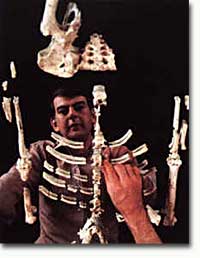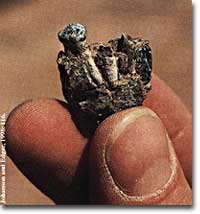1b. Anthropologists and Their People
Finding them didn't come as much of a surprise. Not to David Roberts, anyway. Winding its way across a 117,000-year-old former sand dune was a trail of footprints made by human feet. They are the oldest human footprints ever found.
Roberts is a South African geologist. Previously, he had come across fossilized carnivore tracks in the rock fringing Langebaan Lagoon 60 miles north of Cape Town. And he had noticed rock fragments which showed signs of human use. So: "On a hunch, I began searching for hominid footprints — and found them!"

This photo shows acclaimed paleoanthropologist Donald Johanson with the remarkable skeleton he unearthed in Hadar, Ethiopia, in 1974. It is a 3.5 million-year-old female Australophithecus afarensis, but you can call her Lucy.
"Hundreds of people had walked over that area and not noticed the prints," adds Roberts's colleague, Lee Berger. "Whoever left these footprints has the potential of being the ancestor of all modern humans."
The prints measure eight and a half inches in length. This early person would have taken size 4 shoes.
The Beginning of Time?
When did it all begin? If you had asked Dr. John Lightfoot in 1644, he would have given you a most precise answer. The world was created on October 23, 4004 B.C.E., promptly "at nine o'clock in the morning." Lightfoot, a Hebrew scholar, arrived at the date through exhaustive study of Scripture.
Today we know this underestimates our planet's true age a million-fold. The earth formed 4.6 billion years ago — an almost unimaginably long time. But what of our human past? How far back does it stretch? There are several answers — a series of "firsts":
- 2 million+ years: First Hominids
- 100,000+ years: First Humans
- 9,000 years: First Settlements
- 6,000 years: First Civilizations

In 1572, scientists recovered a strange fossil: the skull of what they thought was an ancient Cyclops. This engraving was made to depict the live creature. As it turned out, the skull they found was simply from an elephant!
All this and more is the province of anthropology. The word means literally "the study of man." We are a complicated species, and anthropologists poke into every aspect of our human nature.
The Caretakers of Culture
Some anthropologists live for years at a time with aboriginal peoples, recording how they organize their lives with the overlay of civilization absent. Margaret Mead, the most celebrated anthropologist of her generation, pioneered this approach in the 1920s when she lived among the Samoan Islanders of the South Pacific. She returned to tell a scandalized world that they practiced free love. Later experts have suggested her adolescent informants fooled the rather ernest young Mead. They were just leading her on.
Other researchers look to our nearest surviving relatives, the great apes, and seek clues to human behavior there. For 40 years Jane Goodall has lived alongside the chimpanzees of Gombe National park in Tanzania. Chimps may look cuddly and cute but they are not above thievery, infanticide, and murder.
Who owns the past? It may sound an odd question, but it is one anthropologists, especially in North America, are having to face. American museums are filled with the skeletons of Native Americans exhumed — looted, if you like — without the permission of their living descendants. In 1990, the Native American Graves Protection and Repatriation Act (NAGPRA) ordered that this material returned to the tribes.

This is the upper right third molar of an unidentified species discovered at the Aramis site in Ethiopia in 1992. The species was later named Australopithecus ramidus and dates back 4.4 million years.
Kennewick Man is at the center of the bitterest dispute. A near-complete human skeleton, it was found along the banks of the Columbia River in Kennewick, Washington, in July 1996. James C. Chatters, the forensic anthropologist who first examined it observed that is characteristics reflected European — not Native American — ancestry.
To Chatters' astonishment when the skeleton was dated, it turned out to be over 9,000 years old. The story made headlines around the world — and a coalition of Indian tribes immediately sued for possession. Ever since the case has been mired in court.
Kennewick Man may reveal fundamentally new facts about the earliest inhabitants of the Americas. If the tribal leaders have their way, he will be reburied at a secret site and his story lost to us all forever. What's the solution? To begin, more trusting relationships between researchers and the people they study must be forged.







